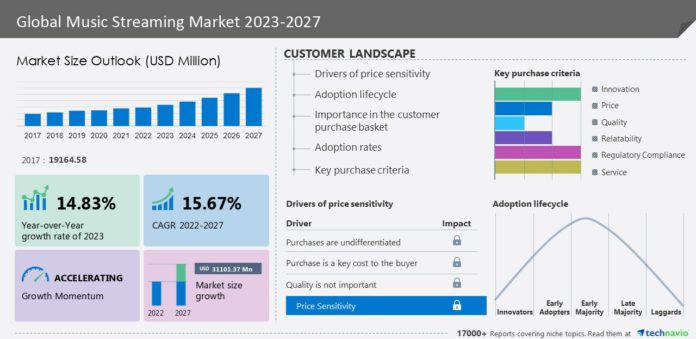

The music streaming market is set to grow by USD 31,101.37 million from 2022 to 2027 progressing at a CAGR of 15.67% during the forecast period. Discover Advertising industry potential and make informed business decisions based on qualitative and quantitative evidence highlighted in Technavio reports.
Key Market Segmentation
This report extensively covers market segmentation by type (free and paid), end-user (individual users and commercial users), and geography (North America, Europe, APAC, South America, Middle East and Africa).
- The market share growth by the free segment will be significant during the forecast period. The free music streaming segment is expected to grow moderately during the forecast period. Providers leverage ad-based models in free music streaming services to generate revenue through ad placements during streaming or in conjunction with in-app purchases. Notably, Spotify and Alphabet are dominant players in the realm of free streaming services. These free subscriptions offer limited music access, coupled with periodic ads. For instance, Spotify’s ad-supported music streaming provides free subscribers access to around 750 songs beyond the on-demand collection, interspersed with ads every two tracks. Similarly, Alphabet permits free users to explore up to 50,000 songs from their music repository, interspersed with ads between tracks. This robust free music streaming segment is anticipated to be a driving force behind the market’s growth during the forecast period.
Regional Market Outlook
North America is expected to account for 44% of the global market growth during the forecast period. The music streaming market in the North American region is expected to register stagnant growth during the forecast period. A pivotal factor contributing to this trend is the early adoption of music streaming services by the United States, a prominent player within the region, which has now reached a state of near-saturation. Notably, the music streaming services market across the region is fortified by an extensive array of music subscribers effectively managed by service providers. This expansion is further accentuated by the decline in sales of physical music components like compact discs (CDs) within the United States, attributed to the widespread prevalence of music streaming services. Engaging in strategic maneuvers, regional players are strategically broadening their operations through partnerships with artists, securing exclusive song rights, and even acquiring smaller entities within the music industry.
Market Dynamics
Driver
Increasing preference for music streaming services is notably driving the growth of the music streaming market. The growing preference for music streaming services is poised to propel market growth throughout the forecast period. A notable surge of one million fresh subscribers gravitates towards music streaming services each month. These services serve as a pivotal deterrent against the unlawful downloading and sharing of music. Remarkably, the majority of these subscribers fall within the age bracket of 18 to 40 years. Among this youthful demographic, there exists a strong inclination towards accessing free music via various platforms. Notably, Pandora extends both paid subscriptions and free channel access, attracting a substantial user base due to its compatibility with diverse operating systems like Android, IOS, and Windows. Furthermore, entities such as Pandora and YouTube are actively exploring diverse avenues to encourage the migration of users from free music streaming to subscription-based models devoid of advertisements.
Trends
The increasing introduction of differentiated music streaming services is an emerging trend shaping market growth. Differentiated music streaming services are progressively being introduced by providers within the music streaming market. Key players like YouTube Music, Pandora, Spotify, Deezer, and Tidal offer an array of distinct features, encompassing seamless cross-platform accessibility, automated playlist tailoring, and superior audio quality. Notably, YouTube Music and Pandora stand out by furnishing users with personalized recommendations, a distinguishing attribute among their counterparts. For instance, Alphabet’s YouTube Music employs artificial intelligence technology alongside user-specific Google account information to curate song selections and recommendations, further enhancing its offerings based on geographical location. Leveraging its patented Music Genome Project, Pandora is venturing into podcast replication, catering to its customer’s preferences. Similarly, Spotify has emphasized social components, ensuring global streaming availability on varied operating systems, including Android, IOS, Windows, and Adobe. Apple and Amazon also contribute to the landscape by rendering music streaming services via their respective hardware platforms. Hence, the mounting embrace of diverse music streaming services stands out as a pivotal trend propelling market expansion during the forecast period.
Challenge
Lack of ownership in music streaming is a significant challenge hindering market growth. Publishing music digitally is a crucial part of music publishing. This sector operates within its own distinct confines, where the dynamics revolve around subscription-oriented licenses that furnish consumers with extensive song repositories. However, a notable drawback inherent to music streaming services is the absence of music ownership for subscribers. Furthermore, not all providers in this domain facilitate music downloads, obliging users to maintain an internet connection for real-time music streaming. The dearth of ownership is poised to discourage potential customers from embracing music streaming services, potentially impeding the market’s growth during the forecast period.
Related Reports:
The music on demand market size is estimated to grow at a CAGR of 13.41% between 2022 and 2027. The music on demand market size is forecast to increase by USD 38,775.66 million. This market report extensively covers market segmentation by type (music streaming and radio on demand), end-user (individual users and commercial users), and geography (North America, Europe, APAC, South America, Middle East and Africa). Increasing preference for music streaming services is notably driving the growth of the music streaming market.
The music production software market size is estimated to grow at a CAGR of 7.47% between 2022 and 2027. The market size is forecast to increase by USD 333.24 million. This report extensively covers market segmentation by type (editing, mixing, and recording), end-user (professionals and non-professionals), and geography (North America, Europe, APAC, South America, Middle East and Africa). The rising number of musicians and artists is driving growth in the music production software market.






